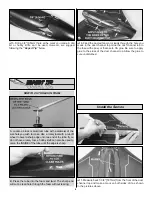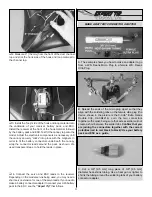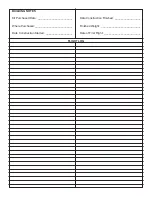
2. You must assemble the model according to the
instructions. Do not alter or modify the model, as doing so
may result in an unsafe or unflyable model. In a few cases
the instructions may differ slightly from the photos. In those
instances the written instructions should be considered
as correct.
3. You must take time to build straight, true and strong.
4. You must correctly install all R/C and other components so
that the model operates correctly on the ground and in the air.
5. You must check the operation of the model before every
flight to insure that all equipment is operating and that the
model has remained structurally sound. Be sure to check
clevises or other connectors often and replace them if they
show any signs of wear or fatigue.
6. If you are not an experienced pilot or have not flown this
type of model before, we recommend that you get the
assistance of an experienced pilot in your R/C club for your
first flights. If you’re not a member of a club, your local hobby
shop has information about clubs in your area whose
membership includes experienced pilots.
Remember: Take your time and follow the instructions to
end up with a well-built model that is straight and true.
WARNING!! Read the entire instruction sheet included with
this battery. Failure to follow all instructions could cause
permanent damage to the battery and its surroundings, and
cause bodily harm!
•
ONLY use a LiPo approved charger. NEVER use a
NiCd/NiMH peak charger!
•
NEVER charge in excess of 4.20V per cell.
•
ONLY charge through the “charge” lead. NEVER charge
through the “discharge” lead.
•
NEVER charge at currents greater than 1C.
•
ALWAYS set charger’s output volts to match battery volts.
•
ALWAYS charge in a fireproof location.
•
NEVER trickle charge.
•
NEVER allow the battery temperature to exceed 150° F [65° C].
•
NEVER disassemble or modify pack wiring in any way or
puncture cells.
•
NEVER discharge below 2.5V per cell.
•
NEVER place on combustible materials or leave
unattended during charge or discharge.
•
ALWAYS KEEP OUT OF REACH OF CHILDREN.
This is a partial list of items required to finish the XPD-8 ARF
that may require planning or decision making before starting
to build. Order numbers are provided in parentheses.
The XPD-8 ARF requires a transmitter that supports elevon
mixing, a micro receiver, one 6" [152mm] servo extension, and
two micro servos (9g or less). If you already have a transmitter
you are going to use to fly the XPD-8 ARF, you can get the
receiver and servos separately:
❏
Futaba
®
R114F 4-channel FM micro receiver w/o crystal
(low band – FUTL0442, high band – FUTL0443)
❏
Futaba FM single conversion receiver crystal for R114F
(low band – FUTL62**, high band – FUTL63**)
❏
(2) Futaba S3110 micro servo 7.7g (FUTM0046)
❏
(1) 6" [152mm] servo extension with “J” connector
(FUTM4506)
Or, you can purchase a complete system (including
transmitter) specially packaged for park flyers. If purchasing
a complete system, the Futaba 3FR Skysport single-stick
radio is suitable. It comes with a micro receiver and two
Futaba S3108 micro servos. The transmitter is also
equipped with a rechargeable NiCd battery pack:
❏
Futaba 3FR Skysport single-stick radio system including
transmitter, receiver, and servos (FUTJ53**)
❏
(1) 6" [152mm] servo extension with “J” connector
(FUTM4506)
Note: The Futaba S3108M and S3110M have the same
specifications as the above mentioned servos, but are
equipped with the Futaba micro plug. These are suitable for
the XPD-8 ARF. However, a receiver with micro plugs such as
the Futaba R124F (low band – FUTL0438, high band –
FUTL0439) and a micro plug servo extension (FUTM4508)
must also be used.
An 11.1V 910mAh lithium-polymer battery pack and suitable
charger are also required. Although there are different
battery packs and chargers available that will work with the
XPD-8 ARF, the economical choices recommended by
Great Planes are:
❏
Great Planes 11.1V 910mAh LiPo (GPMP0605) battery pack
❏
Great Planes ElectriFly
™
DC peak charger (GPMM3010)
Radio Equipment & Electronics
DECISIONS YOU MUST MAKE
LITHIUM BATTERY HANDLING & USAGE
We, as the kit manufacturer, provide you with a top quality,
thoroughly tested kit and instructions, but ultimately the
quality and flyability of your finished model depends on
how you build it; therefore, we cannot in any way
guarantee the performance of your completed model, and
no representations are expressed or implied as to the
performance or safety of your completed model.
3


































